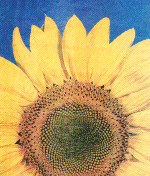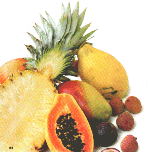
If DNA is the building blocks of biology then maths maybe the builder,finds
Simon Singh
It is very rare that I find myself standing in my local supermarket staring at the surface of a pineapple.But that is what happened soon after I heard Ian Stewart give a lecture on the subject of his latest book. Stewart,who is one of Britain's most prominent mathematicians,has recently become interested in a new area of research at the frontier between biology and mathematics,which is already providing some startling insights into the living world......including pineapples.

Biomathematics is a reaction against the worship of DNA,and the opinion that
genes govern all aspects of of life [Genetic Determinism
-LB]. DNA is essentially a complex set of instructions,and in recent
decades there has been a growing belief that it is this strand of molecules
which guides all aspects of life.
|
|
|
| A cross section through bamboo showing the arrangement of fibre bundles | Pine cones with two opposing spirals - nature exploiting maths |
The seed head of a flower - such arrangements maximise the packing of seeds |
However,if one looks at the instructions that would be required to dictate
the nerve by nerve construction of the human nervous system, then it is clear
that our DNA cannot carry enough information to complete this task,let alone
all the others. Biomathematics claims that the information gap can be closed
by invoking mathematics and the laws of physics.
Physics and mathematics are capable of producing intricate patterns in
non-organic constructions (for example,
snowflakes
and sand dunes). They can offer a range of patterns
which will emerge
spontaneously, given the correct starting conditions.The theory which
is currently gaining support says that life operates by using DNA to create
the right starting conditions,and thereafter physics and maths do all the
rest,DNA is not the secret of life - hence the title of the book
(Life's Other Secret: The New Mathematics of the Living World -
Ian Stewart).
The strange case of the fascinating pineapple begins with the observation
that its surface is covered in diamonds,which form two sets of spirals,twisting
in opposite directions.There are 8 sloping to the left,and 13 sloping to
the right.These numbers are special because they are part of
the Fibonacci
sequence (1,1,2,3,5,8,13,21,34,55...),in which the next number
in the series is generated by adding the two previous numbers,ie 1+1=2 and
1+2=3,and so on.
 |
Pattern by Numbers Seeds in a sunflower head are usually arranged in 34 clockwise and 55 anti- clockwise spirals |
The sequence crops up in many other plants,such as in the arrangement
of seeds in the head of a sunflower which usually has 34 spirals going
clockwise,and 55 going anti-clockwise.So far,this is just an observation,but
biomathematics seeks to find an explanation.
An elegant argument in Ian Stewart's book explains that evolution encourages
as many seeds as possible,physics provides the mechanism for packing them
in most tightly,and mathematics leads to the Fibonacci sequence.
Stewart describes beautifully a whole series of of biological phenomena which
can be elucidated by mathematics: the formation of the stomach in a frog
embryo,the life cycle of the slime mould [Ref:Prof Bonner - Slime
Moulds Cyclic AMP],the
patterns on the
skin of angel fish and tigers,the movement of bipeds,quadrupeds and
hexapods,and animal behaviour.He does not have all the answers,but bear in
mind that biomathematics is a recent development in science,and as compensation
we get to see a subject full of controversy and youthful enthusiasm.

Finally,there may be people who suspect that the influence of mathematics can only serve to provide a more sterile view of life.This is not the case.The combination of DNA and mathematics enriches biology,and magnifies the wonder of life.Personally,I have found that my love of pineapples has grown enormously since learning about the mathematics of its surface.

Simon Singh is
a television producer and author of
"Fermat's Last
Theorem" (Fourth Estate).
| UNIVERSAL VEINS. Despite the stunning variety of leaf shapes
from one plant variety to another, a universal formula may guide the vein
patterns in all leaves. Researchers at the Laboratorie de Physique Statistique
(S. Bohn, 33-1-4432-3447,
[email protected]) and the Museum National
d'Historie Naturalle, both in Paris, recently studied the networks of veins
in leaves from several plant types. An analysis of leaf vein networks revealed
simple relationships between the angles that veins form when they intersect
and the thickness of the veins at the intersections. At a three-way junction
of similarly sized veins, the angles between the veins are all roughly 120
degrees (see image at
www.aip.org/mgr/png). At locations
where a small vein joins a large vein, however, the angles between the small
vein and the larger one approach 90 degrees. Imagine, for example, the angles
formed by pulling on a light thread tied to a taut rope. The similarity between
a network of threads and ropes exerting forces on each other and the patterns
in leaf veins suggested to the researchers that there is an underlying mechanism
in leaf formation that is reminiscent of simple mechanics problems. The model
breaks with theories of leaf networks related to soap froths (which require
all intersection angles to equal 120 degrees), crack propagation (with 90
degree intersections where new cracks meet old cracks), and
Turing diffusion
(which leads to patterns that resemble spreading tree branches, rather
than the net-like patterns found in leaf veins). Some botanists had considered
leaf veins as potential tools for categorizing plants. The universal similarity
of vein structure from one plant to another suggests that the patterns provide
insight to leaf mechanics, but are of little help in distinguishing or cataloging
plants. (S. Bohn et al., Phys. Rev. E, June 2002; text at
www.aip.org/physnews/select) |
"There is not a fine tree producing rotten fruit;again there
is not a rotten tree producing fine fruit. For each tree is known by
its own fruit"
- Luke 6:43,44 -quoted in "What has religion done for mankind?"
| "Even from the standpoint of the skeptic,a reasonable and
candid search into the unknown,by the light of what is known,will guide the
ubiased,intelligent reasoner in the direction of truth. Yet it is evident
that without a direct revelation of the plans and
purposes of God,men could only approximate the
truth,and arrive at indefinite conclusions.But let us for the moment lay
aside the Bible,and look at things from the standpoint of reason
alone. He who can look into the sky with a telescope,or even with his natural eye alone,and see its symmetry,beauty,order,harmony and diversity,and yet doubt the Creator of these is vastly his superior both in wisdom and power,or who can suppose for a moment that such order came by chance,without a creator,has so far lost or ignored the faculty of reason as to be properly considered what the Bible terms him,a fool (one who ignores or lacks reason):"The fool hath said in his heart,There is no God." However it happened,at least that much of the Bible is true,as every reasonable mind must conclude;for it is a self evident truth that effects must be produced by competent causes.Every plant and every flower,even speaks volumes of testimony on this subject. Intricate in construction,exquisitely beautiful in form an texture,each speaks of wisdom and skill above human.How short sighted the absurdity which boasts of human skill and ingenuity,and attributes to mere chance the regularity,uniformity and harmony of nature;which acknowledges the laws of nature,while denying that nature has an intelligent Lawgiver." -"The Divine Plan of the Ages" [Ignorant nonsense-LB] |
Life's Other Secret: The New Mathematics of the Living
World - Ian Stewart |
| Chaos | Quantum | Logic | Cosmos | Conscious | Belief | Elect. | Art | Chem. | Maths |